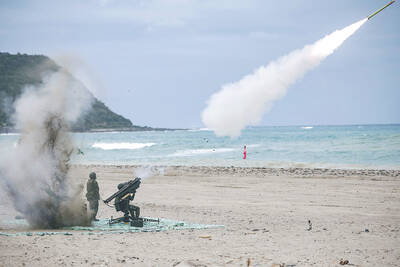A dancer in harem pants moves down a Berlin street next to a skinhead wearing a “Reich” flag: Germany’s escalating anti-mask protests in the coronavirus pandemic draw from a wide, seemingly contradictory range of political camps.
A rally of nearly 10,000 opponents of government-imposed social restrictions to curb the spread of COVID-19 in Berlin last week brought together a motley band of demonstrators with ostensibly little in common — apart from crumbling faith in institutions and representative democracy.
The scene in front of the Brandenburg Gate Wednesday marked a dizzying confluence of LGBT rainbow flags and Gandhi banners intermingled with posters for the increasingly international QAnon conspiracy movement.

Photo: Reuters
Marchers wearing red Trump “MAGA” hats could be spotted in the crowd next to evangelicals, climate activists and “peace”-shouting hippies.
Most of the protesters remained peaceful while they railed against vaccines and dismissed the dangers of the virus, but a violent hard core attacked police.
Some 77 officers were injured at the demonstration, with Berlin police chief Barbara Slowik saying that “the brutality of the violence was immense.”

Photo: Reuters
“Some have told me that we have not experienced something like that in decades,” she told the Tagesspiegel daily. “We are moving away from a very colorful public and are now increasingly dealing with a spectrum of people who generally reject our system and are prepared to use extreme violence.”
Repeating a common but false refrain of the demonstrations, one protester, Ina Meyer-Stoll, claimed: “The death rate isn’t higher than ones you see for flu outbreaks.”
Another activist on the streets, Achim Ecker, an erstwhile Greens voter in his 50s, said he had “lost confidence in the political parties” particularly with regard to potential approval of a vaccine.

Photo: AFP
Others’ harmless appearance belied jaw-dropping views.
Grandmother Birgit Vogt, 75, denied the existence of the pandemic and didn’t hesitate to draw a parallel between the restrictions and the seizure of dictatorial powers by the Nazis in 1933: “Fear and panic allow you to control the masses, as in Hitler’s time.”
“Just like after 9/11, which gave way to countless conspiracy theories, I worry that we’re seeing the same phenomenon with the pandemic,” warned Miro Dittrich of the anti-extremism group Amadeu Antonio Foundation.

Photo: AFP
He said that such movements were “dramatically increasing their followers and many are newcomers. The shutdown has played a role, as people are cut off from their social environment and spend an extremely large amount of time online.”
In the meantime, right-wing extremist groups and the far-right Alternative for Germany (AfD) party have been effective in harnessing a wide range of objections to the government response to the pandemic.
On Wednesday, about a dozen demonstrators began shouting “Sieg Heil” while performing the banned stiff-armed Hitler salute, in the presence of police.
Anti-Semitic slogans have been a fixture of some of the corona-skeptic demonstrations in Germany this year. “The link between the conspiracy theorist scene and the far right is unfortunately quite logical because they have a lot in common,” Dittrich said. “Both believe that a small elite secretly controls events at the expense of ‘the Germans,’ as well as controlling the mass media, and that the truth can only be found in ‘alternative’ media.”
The umbrella group for most of the demonstrations since the outbreak of coronavirus is called Querdenken or “Lateral-thinkers.”
Founded in Stuttgart, it calls itself a “freedom movement” that embraces “peaceful and non-partisan” ideals and claims to have more than 100,000 supporters, including personalities such as international footballer Thomas Berthold.
But “the organizers of Querdenken have shown in the past that they’re not afraid of contact with the (virus) deniers and conspiracy theorists,” warned Simon Teune, a researcher at Berlin’s Technical University who specializes in protests.
The Office for the Protection of the Constitution, Germany’s domestic intelligence service, in the state of North Rhine-Westphalia, has sounded the alarm over the rallies.
“The original intention of the demonstrations — namely to protest against the measures initiated by the state — is often overshadowed,” it said. “Instead, they are being used to turn governments and the media themselves into ‘objects of protest and hatred.’”

In late October of 1873 the government of Japan decided against sending a military expedition to Korea to force that nation to open trade relations. Across the government supporters of the expedition resigned immediately. The spectacle of revolt by disaffected samurai began to loom over Japanese politics. In January of 1874 disaffected samurai attacked a senior minister in Tokyo. A month later, a group of pro-Korea expedition and anti-foreign elements from Saga prefecture in Kyushu revolted, driven in part by high food prices stemming from poor harvests. Their leader, according to Edward Drea’s classic Japan’s Imperial Army, was a samurai

Located down a sideroad in old Wanhua District (萬華區), Waley Art (水谷藝術) has an established reputation for curating some of the more provocative indie art exhibitions in Taipei. And this month is no exception. Beyond the innocuous facade of a shophouse, the full three stories of the gallery space (including the basement) have been taken over by photographs, installation videos and abstract images courtesy of two creatives who hail from the opposite ends of the earth, Taiwan’s Hsu Yi-ting (許懿婷) and Germany’s Benjamin Janzen. “In 2019, I had an art residency in Europe,” Hsu says. “I met Benjamin in the lobby

April 22 to April 28 The true identity of the mastermind behind the Demon Gang (魔鬼黨) was undoubtedly on the minds of countless schoolchildren in late 1958. In the days leading up to the big reveal, more than 10,000 guesses were sent to Ta Hwa Publishing Co (大華文化社) for a chance to win prizes. The smash success of the comic series Great Battle Against the Demon Gang (大戰魔鬼黨) came as a surprise to author Yeh Hung-chia (葉宏甲), who had long given up on his dream after being jailed for 10 months in 1947 over political cartoons. Protagonist

A fossil jawbone found by a British girl and her father on a beach in Somerset, England belongs to a gigantic marine reptile dating to 202 million years ago that appears to have been among the largest animals ever on Earth. Researchers said on Wednesday the bone, called a surangular, was from a type of ocean-going reptile called an ichthyosaur. Based on its dimensions compared to the same bone in closely related ichthyosaurs, the researchers estimated that the Triassic Period creature, which they named Ichthyotitan severnensis, was between 22-26 meters long. That would make it perhaps the largest-known marine reptile and would